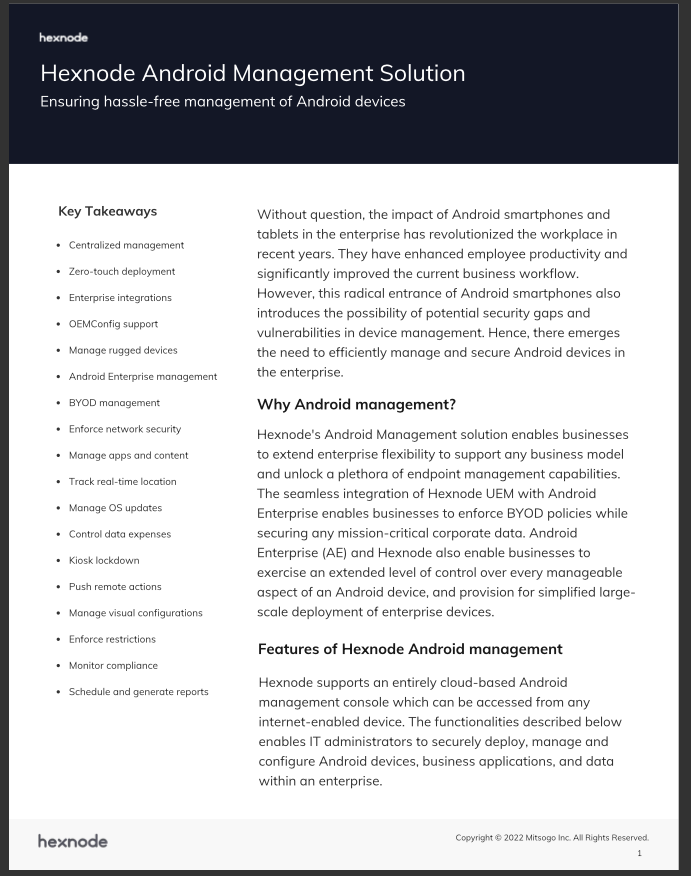What is Android malware?
Android malware is a malicious software that is intended to harm or corrupt computer systems. Malware developers employ several methods to infiltrate devices and networks. The goal, like with any malware, is to damage the device and steal personal data.
How malware affects your device and data?
How it enters a device
Downloading harmful applications – Apps and downloadable content are the most prevalent way hackers transmit malware. Apps obtained from an official app store are generally secure. Apps obtained through unauthorized means, such as from cracked versions or from illegal sources, can contain viruses.
Using a smartphone or tablet with operating system flaws – Mobile devices are often exploited by hackers due to flaws in the OS. If you don’t keep your device’s software up to date, it will be vulnerable to these flaws, which are usually quickly identified and fixed.
Using insecure Wi-Fi or URLs – Public WiFi networks are often unsecured, which means that hackers can easily intercept and read your data as it’s transmitted over the network. Furthermore, it can be used to spread malware and viruses to connected devices. Additionally, there is a risk of compromising sensitive data from your device if you visit unsecured websites. Using your phone’s browser can potentially expose you to various risks which may result in web browser assaults. These kinds of attacks are more widespread on Android smartphones.
Phishing through text message or voicemail – You may receive a text message or a call from what looks to be a reputable source requesting personal information about you or your device. Hackers frequently utilize this information to steal any data they find, like social security numbers, credit card information, and so on. Furthermore, unsecured website URLs can also be shared to the user through text messages that can compromise your phone’s software.
Effects on the device
- Malware in the form of advertisements frequently gathers fake clicks and can make your phone extremely inconvenient to use. In contrast, malware targeting Android devices can lead to even more severe consequences, such as the theft of personal information from your phone.
- Attackers can steal credentials from any of your accounts and use that to steal your identity. Additionally, users are at risk of financial loss as a result of these attacks.
- Once permission is granted, the malware’s actions become invisible on the device, making it difficult to detect and stop.
- Hackers may also use malware to acquire and sell your contact and device information, resulting in a stream of robocalls and messages. Furthermore, they can also distribute links to more spyware to everyone on your contact list.
Types of malwares
There are several types of malwares that exist, each with its own unique characteristics and capabilities.
Viruses
These are the most well-known type of malware, and are designed to replicate and spread across a computer or network. They often attach themselves to other legitimate files and can cause damage or corrupt data.
Worms
Similar to viruses, worms are also designed to spread across a network, but they do not require the activation of a host file to do so. Once a worm has entered your system, it will run and propagate itself without any trigger or action from the user. Furthermore, they can cause damage by consuming bandwidth or resources, and can also serve as a means for hackers to gain access to a network.
Trojans
These are malicious programs that are disguised as legitimate software, and are often used to gain access to a computer or network. Furthermore, they can be used to steal sensitive information, or to install other types of malwares on a device.
Ransomware
This type of malware encrypts a user’s files and demands payment in exchange for the decryption key. Furthermore, it can cause significant damage to businesses and individuals, as it can prevent access to important data and systems.
Adware
Adware is a type of malware that displays unwanted advertisements on a user’s computer or mobile device. It can slow down the performance of the device and cause pop-ups and banners to appear on the screen.
Rootkits
These are a type of malware that are designed to hide the presence of other malware on a device, making them difficult to detect and remove. Furthermore, they can be used to gain access to sensitive information or to carry out other malicious activities.
Spyware
This is a type of malware that is designed to collect and transmit personal information about a user, such as browsing history, keystrokes, and login credentials. The information can be used for identity theft or targeted advertising.
It is important to be aware of these different types of malwares and take precautions to protect yourself from them. Keeping your software and devices up-to-date, using anti-virus and anti-malware software, and being cautious when downloading files or clicking on links can help to minimize the risk of infection.
Preventing a malware attack
It is always better to take the necessary steps to prevent such an attack. The loss from an attack is much more than the cost of protection. Furthermore, the cost to the firm surpasses the gain to the attacker since their reputation is harmed. Thus, enterprises should regularly monitor the health of the devices.
Why be careful?
The presence of malware can disrupt regular device usage and cause inconvenience. Further, it interferes with how you regularly use your device and makes you feel anxious even if you’re not sure what’s triggering the problem. Malware exploits phone vulnerabilities to obtain access to sensitive data by granting itself administrator permissions. So, this might be disastrous for the organization because it will no longer prompt for or ask for access authorization.
Best practices to prevent Android malware attacks
Even though Android developed mechanisms to protect your devices from the hazards of runtime permissions, cyber-attackers are inventing new ways to exploit this feature. In order to safeguard your company’s Android devices, it is crucial to exercise caution and employ security solutions. Some of the healthy practices are:
Regular OS updates
Many businesses demand that their devices be upgraded to the most recent Android OS versions. Running an old OS version can pose several security risks. Additionally, some apps may not function properly on machines running obsolete software. Regularly updating the OS maintains the security and health of your Android devices.
Configuring network settings
Admins should pre-configure the Wi-Fi settings for registered devices to connect instantly to the workplace network when they arrive at the office. The VPN configuration is advantageous when accessing the internet via public Wi-Fi, whether for personal or corporate needs. The data transfer is not available to anybody else on the network since the connection is protected. As a result, it prevents anyone from snooping on important information.

Separate work and personal profiles
Work profile in Android assists enterprises in preventing unintentional data breaches via BYOD smartphones. The work profile establishes a container in an employee’s device that isolates work apps and data from personal data. The organization may control all of the data included within this container.
Allowlisting and denylisting apps and websites
By banning certain applications, organizations can prevent the use of potentially harmful apps or websites and restrict access to unwanted content on their devices. The denylist function prevents users from accessing any applications or URLs put on the list. Allowlist, on the other hand, prevents users from utilizing applications and websites other than those that have been allowlisted.
Scheduled device scans
Devices must be scanned periodically to retrieve device data. Scanning the device will update the IT admins with the device health, list of installed apps, and other device characteristics.
Remote monitoring and auditing devices
IT admins must monitor devices in real-time remotely. Device health alerting is a preventative tool that businesses utilize to keep ahead of device health concerns. The IT administrator needs to be alerted when a problem or unwanted modification happens in a device.
A Unified Endpoint Management solution such as Hexnode helps enterprises set up these much-needed security procedures across multiple devices easily. Its various app management and remote management features lets the IT admins ensure device security from Android malware.
Be very cautious about the following:
Your smartphone has been rooted – Rooting is the process of gaining root access to the Android OS code. It allows you to alter the device’s software code or load other software that the manufacturer would ordinarily not allow you to do. Furthermore, gaining root access includes overcoming the Android operating system’s security constraints. Worms, viruses, adware, and Trojans can infect rooted Android software if an efficient Android mobile antivirus does not protect it.
Your Android OS is no longer getting updates – Because of Android malware, your Android OS might not get upgraded to the newest version despite being compatible. Additionally, your device might not receive any notification about new updates.

Featured resource
Hexnode Android Management Solution
Learn how Hexnode’s Android Management solution helps businesses ensure seamless deployment, configuration, regulation, monitoring, and supervision of end-user devices.
Download the datasheetDetecting malware attacks
Anyone using the internet is sure to come across malware at some point. If your device includes a lot of your sensitive data, it is a perfect target for fraudulent operators.
Malware symptoms on Android devices
Some Android malware symptoms are as follows:
- Your phone frequently overheats.
- Battery drainage is faster than expected.
- Pop-up advertising is common. Hence, you may also see strange adverts that are occasionally ‘too personal.’
- The phone’s performance is inadequate.
- Apps take too long to launch, do not open at all, or crash.
- You discover apps that you don’t recall downloading.
- Get high phone bills.
- You notice an unexpected spike in data consumption.
Ways to spot attacks
Using Play Protect
- Click the menu button or profile icon in the Play Store app. This is done by tapping on the three-line symbol or profile picture in the top corner.
- Choose Play Protect and tap on Scan. Your smartphone will begin scanning for Android malware.
- If your smartphone detects potentially hazardous apps, it will provide the choice to remove them.
Using system apps
You can also scan your Android smartphone manually for security risks:
In Settings, choose Battery and Device Care. Next, select Device security and then click on Scan your phone. All of your device’s apps and data will be examined. When the scan is finished, you will be informed whether or not your device is secure.
In certain devices, the Security icon is present on the home screen. On opening that, you can tap on Security scan to check the health of your device.
Making things right: How to remove Android malware
Restart your device in safe mode.
Safe mode enables you to disable any third-party programs and services, allowing you to remove malware as well. Once you open the device in safe mode:
- If you come across an unknown suspicious software that you can’t uninstall, it’s likely the malicious app you’re looking for.
- Disable the app from the Settings app list.
- Locate the malicious app in the Device admin apps list and disable the toggle next to it.
- Return to the applications list, pick the possible malware, and then hit Uninstall.
- Remove untrusted apps – You can also remove apps directly without having to log into safe mode. You can find the list of apps in the setting and uninstall all the unwanted ones.
Using remote app management of Hexnode
It can be challenging for IT admins to manage the security of multiple devices individually. Hexnode’s remote app management features let the admins configure and push settings on multiple devices simultaneously. Using Hexnode, Android malware can be removed by:
- Removing all downloads and caches. You can clear all app data, restrict users from installing apps from unknown sources, hide the Google Play store, verify each app before installation, and more.
- Wiping a device is the last resort to any malware attacks on the device. The two ways to wipe a device using Hexnode are Device wipe and Enterprise wipe. While Device wipe clears all contents from the device’s storage, and you get the device the way it was unboxed, Enterprise Wipe eliminates everything pushed through the UEM console.
A third-party antivirus app can also be used as a method to detect, prevent, and remove malware from an Android device. In such cases, it is advisable to go for trusted and renowned apps only, as there are plenty of apps in the market that can cause more damage to the device.
Conclusion
Android malware can cause havoc on the device and the data. The impact of this can’t be described in words. Therefore, it is very crucial to take the necessary steps to prevent such attacks, at the same time, be prepared with how to tackle them in case a mishap happens.
Looking for a UEM solution?
Try out Hexnode to prevent your Android devices from malware attacks.
Sign up now





